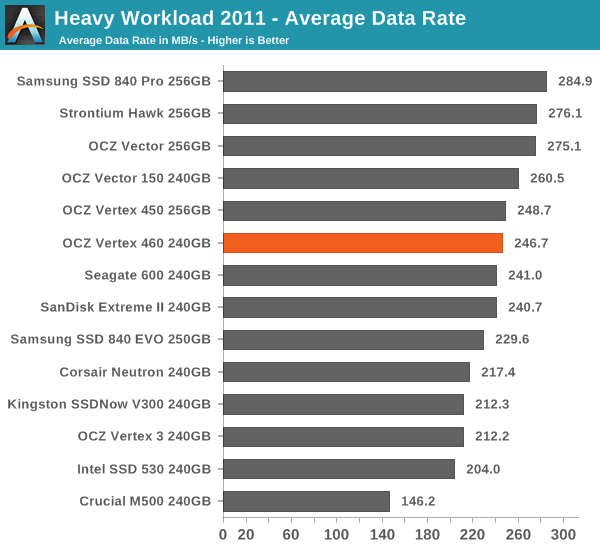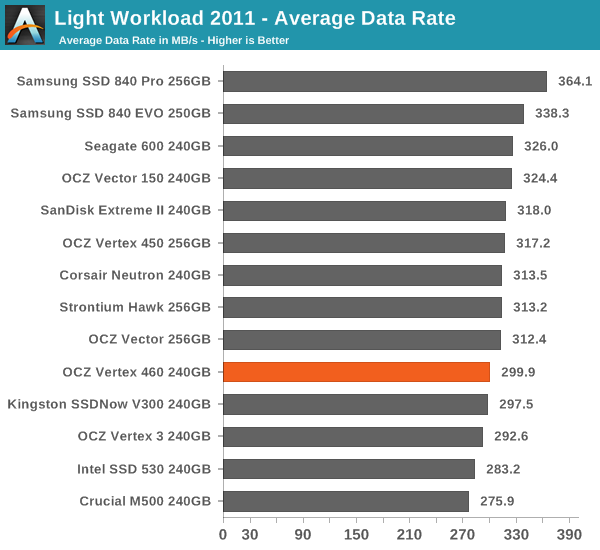OCZ Vertex 460 (240GB) Review
by Kristian Vättö on January 22, 2014 9:00 AM EST- Posted in
- Storage
- SSDs
- OCZ
- Indilinx
- Vertex 460
AnandTech Storage Bench 2011
Two years ago we introduced our AnandTech Storage Bench, a suite of benchmarks that took traces of real OS/application usage and played them back in a repeatable manner. Anand assembled the traces out of frustration with the majority of what we have today in terms of SSD benchmarks.
Although the AnandTech Storage Bench tests did a good job of characterizing SSD performance, they weren't stressful enough. All of the tests performed less than 10GB of reads/writes and typically involved only 4GB of writes specifically. That's not even enough exceed the spare area on most SSDs. Most canned SSD benchmarks don't even come close to writing a single gigabyte of data, but that doesn't mean that simply writing 4GB is acceptable.
Originally the benchmarks were kept short enough that they wouldn't be a burden to run (~30 minutes) but long enough that they were representative of what a power user might do with their system.
1) The MOASB, officially called AnandTech Storage Bench 2011 - Heavy Workload, mainly focuses on the times when your I/O activity is the highest. There is a lot of downloading and application installing that happens during the course of this test. Our thinking was that it's during application installs, file copies, downloading and multitasking with all of this that you can really notice performance differences between drives.
2) We tried to cover as many bases as possible with the software incorporated into this test. There's a lot of photo editing in Photoshop, HTML editing in Dreamweaver, web browsing, game playing/level loading (Starcraft II & WoW are both a part of the test) as well as general use stuff (application installing, virus scanning). We've included a large amount of email downloading, document creation and editing as well. To top it all off we even use Visual Studio 2008 to build Chromium during the test.
The test has 2,168,893 read operations and 1,783,447 write operations. The IO breakdown is as follows:
| AnandTech Storage Bench 2011 - Heavy Workload IO Breakdown | ||||
| IO Size | % of Total | |||
| 4KB | 28% | |||
| 16KB | 10% | |||
| 32KB | 10% | |||
| 64KB | 4% | |||
Only 42% of all operations are sequential, the rest range from pseudo to fully random (with most falling in the pseudo-random category). Average queue depth is 4.625 IOs, with 59% of operations taking place in an IO queue of 1.
AnandTech Storage Bench 2011 - Heavy Workload

The full results, including disk busy times and read/write separations, can be found in our Bench.
AnandTech Storage Bench 2011 - Light Workload
Our light workload actually has more write operations than read operations. The split is as follows: 372,630 reads and 459,709 writes. The relatively close read/write ratio does better mimic a typical light workload (although even lighter workloads would be far more read centric). There's lots of web browsing, photo editing (but with a greater focus on photo consumption), video playback as well as some application installs and gaming.
The I/O breakdown is similar to the heavy workload at small IOs, however you'll notice that there are far fewer large IO transfers. Interestingly, the 480GB drive actually comes out ahead in this case, suggesting it's more capable at light workloads.
| AnandTech Storage Bench 2011 - Light Workload IO Breakdown | ||||
| IO Size | % of Total | |||
| 4KB | 27% | |||
| 16KB | 8% | |||
| 32KB | 6% | |||
| 64KB | 5% | |||











69 Comments
View All Comments
Kristian Vättö - Wednesday, January 22, 2014 - link
All OEMs do cherry-picking, so blaming OCZ is useless. However, in SSDs it doesn't matter that much because NAND is binned for endurance, not performance. While there can always be minor differences in performance between units, it's nowhere near as big as in e.g. CPUs.As for buying review samples, that would not be financially efficient. Consumer Reports and the like are different because they're funded by the government or other huge organisation, whereas we are private. Furthermore, we wouldn't be able to deliver reviews on time for release because we'd have to wait for retail availability like everyone else.
FunBunny2 - Wednesday, January 22, 2014 - link
I can 'buy' the second reason, but Anand can't afford a $300 SSD? Come on.bhaberle - Wednesday, January 22, 2014 - link
So you are telling me you would be okay with spending at minimum, tens of thousands of dollars on parts? Sure that is just ONE $300 SSD. What about about the other 15+ that they would need to get. Be realistic. If it is not a big deal, why don't you go buy that many. Sure they make money with this site, but it would take some time just to break even on the costs of the parts even for a large site like Anandtech. If you don't appreciate the effort they put in their reviews then stick to consumer reports.blanarahul - Wednesday, January 22, 2014 - link
That's what I said.BTW, can you guys test Samsung XP941?? And if possible, a comparison with 2 840 Pros in SLI.
Uhh. RAID..
Kristian Vättö - Friday, January 24, 2014 - link
I asked Samsung for a sample a while back but they wouldn't send us one since it's an OEM-only product. However, Anand got a pair of XP941s in the new Thunderbolt 2 equipped LaCie drive... ;-)henrybravo - Wednesday, January 22, 2014 - link
Great comment. Blame company PR, not Anandtech.PEJUman - Wednesday, January 22, 2014 - link
I own various branded SSDs, Intel, OCZ, Corsair to name a few.Some fails some don't (yes, even my intel X25-M G2 failed me at one point).
In the end, Anandtech readers are typically smart enough to run backups so any failures like that is not a big deal.
I form my own price/performance/risk assesment:
I use newegg, amazon, slickdeals, camelx3 for price.
Anandtech, Toms and forums for performance.
and lastly verified buyer comments at newegg & amazon for risk.
I could care less about a brand or what color is the box of my CPU/GPU.
MrSpadge - Wednesday, January 22, 2014 - link
And some people are obsessed with hating OCZ. Sure they made several mistakes, some not directly related to their technology. But that happened years ago. Sit back and see how the new drives developed in coorporation with Toshiba work out. Judge those drives by what they are, not what their grand-grandfathers were.Bob Todd - Wednesday, January 22, 2014 - link
You make it sound like all of their problems with quality control and high failure rates happened in the ancient past. This site's Vector review sample died during testing less than 3 months ago. I'm on my 3rd Agility 4 after RMAs and this one needs to go back too. That drive only came out ~18 months ago. I'd be happy to embrace a new wave of OCZ SSDs that were reliable, but we won't know how well (or if) they've managed to turn things around until we get several models in consumers hands and have adequate time to judge reliability.Roland00Address - Thursday, January 23, 2014 - link
OCZ has made plenty of shitty ssds in the last 3 years. I will be happy to buy a OCZ/Toshiba SSD but not until they have a track record of 3 good years for their ssds.Why deal with the head ache of your computer going out or your data corrupted just to save $10 or $20 dollars?